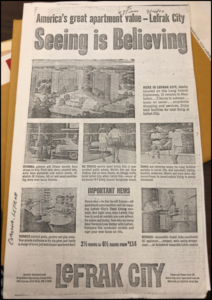
Source: Queens Public Library Archive’s folders on Samuel J. LeFrak and LeFrak City
By Lindsay Holcomb
In the heart of Queens, along the busy Long Island Expressway, stand 20 identical brown buildings, each 16 stories tall and emblazoned with gaudy, golden letters reading L-E-F-R-A-K. The cluster of structures is unmissable, towering exotically over the single-family residences, strip malls, and auto body shops that predominate in the Corona and Elmhurst neighborhoods. This is the world’s first “city within a city,” a gated 28-square-block complex where there is no traffic, and apartments are adjacent to luxury amenities and basic public services.
The LeFrak Organization, the biggest real estate developers in New York throughout much of the 20th century, acquired the land on which LeFrak City now stands in 1955. According to a New York Times article written at the time, the site had previously been owned by billionaire John Jacob Astor and Lord William Waldorf Astor of England, and before them, by the eighth President of the United States, Martin Van Buren. Inspired by the elite pedigree of the land parcel’s previous owners, Samuel J. LeFrak, then the president of the LeFrak Organization spared no expense in converting the parcel of land into an enormous, opulent housing complex.
An article from the Long Island Free Press in 1960 reported that LeFrak City was the largest apartment development in the world constructed exclusively with private financing and without tax abatements or government assistance. Construction on the site took nine years, culminating in 1964 to coincide with the World’s Fair, which was held just a mile away in Flushing, Queens. A Long Island Post article from that year reported that Samuel J. LeFrak was honored with the World’s Fair Silver Medallion, and LeFrak City was designated as “Building of the Week” at General Electric’s Pavilion, “Progress Land.” The entire project cost the LeFrak Organization $125 million, or just over $1 billion today.
From its outset, the project was extraordinarily ambitious. The LeFrak Organization wasn’t just designing apartments, but a new way of living. Never before had a private developer attempted to build a community, both socially and psychically. LeFrak wanted to bring people together and then keep them together through the allure of luxury amenities and shopping. Inspired no doubt by the theories of psychogeography popularized during this period by Guy DeBord and Walter Benjamin, the LeFrak organization intended to create an urban environment, consciously organized to foster togetherness and ease.
The 20 buildings in LeFrak each possessed names that reflected the global vision of the development – the “Mexico,” the “Canada,” the “Copenhagen,” and the crown jewel, “the United States.” In 1964, the New York Herald Tribune wrote that in the previous year, Samuel LeFrak went out on a tour of the Far East, the Middle East, and Europe to study housing and returned with inspiration for his development, particularly for what he referred to as the “Supermarket approach” to building apartments. Though LeFrak never would have admitted it given the Cold War tensions of the time, LeFrak City’s simple, homogenous design most closely paralleled the Soviet khrushchyovkas of the period – industrialized, pre-fabricated buildings with identically designed apartments.
“People from all parts of the world who live in peace and comfort here will find that life can still have another dimension,” LeFrak told New York City Council members in 1964. “The working man will live with more recreational and community comforts surrounding him than did the millionaires of America at the turn of the century. There are only two things required. The first is concern or the will to provide them and the second is imagination so that one may foresee and anticipate those things that make for a fuller life.”
In LeFrak’s conception, renting an apartment in LeFrak City demanded not only a financial commitment, but also an ideological one. The 25,000 tenants of the complex had to buy into the idea of “total living,” which is to say, they had to accede to the concept that every service and amenity they could possibly need will be located inside of LeFrak City and owned and operated by the LeFrak Corporation. Except to commute to jobs outside, residents never needed to leave the complex, for just outside their doors, they could find what one 1964 advertisement described as “101 total living facilities” – more than 20 garden, parks and playgrounds, an ice skating rink, a roller rink,a heliport, a shopping center with luxury stores, two theaters, half a dozen tennis courts, 10 swimming pools, a putting green, and underground parking garages. There was also a pre-school, a public library branch, a number of restaurants and bars, a doctors’ office, a dentists’ office, and a post office.
These amenities were just one of the four dimensions of total living listed in a 1965 advertisement in the New York Times for LeFrak City. “You deserve the best!” the advertisement reads. “Total living, total safety, total financial security, total suburbia.” Only at LeFrak City, could one take a dip in the community pool and leave their wallet and keys on their chaise lounge without worry. A security team of more than 100 men guarded the complex as well as a fleet of doormen and 24-hour gatehouse attendants. Almost everyone in the security force was had formerly been in the New York Police Department.
“Living in LeFrak is like being in one big bomb shelter,” Judy Kosches, a LeFrak City tenant told a New York Times reporter in 1965. “You hardly even have to go above ground for anything.”